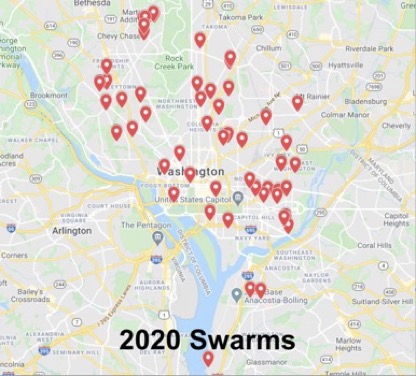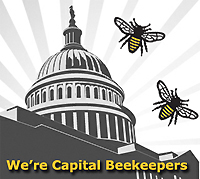Swarm Trap Project
 Swarms are a natural and healthy part of honey bee colony reproduction. However, Spring honey bee swarms can be a nuisance and a little scary for the non-beekeeper. Last year DC experienced a very swarm-filled Spring. This year the DC Beekeepers Alliance has launched a project to deploy honey bee swarm traps throughout the city.
Swarms are a natural and healthy part of honey bee colony reproduction. However, Spring honey bee swarms can be a nuisance and a little scary for the non-beekeeper. Last year DC experienced a very swarm-filled Spring. This year the DC Beekeepers Alliance has launched a project to deploy honey bee swarm traps throughout the city.
Swarming is a honey bee colony's natural means of reproduction. In the process of swarming, a single colony splits into two or more distinct colonies. The queen flies off with half the worker bees from the hive to found a new colony. She leaves behind eggs the original colony will raise to be their new queen.
Swarm traps (sometimes referred to as bait hives), are sturdy boxes designed to lure a honey bee swarm to move in and make a new home. They are generally placed 5 to 20 feet above the ground. These boxes are most likely to lure a swarm if they are placed 100 to 300 yards from an apiary. This project has more than 60 swarm traps deployed throughout the city, most of them in areas where bee swarms were captured last year.
Each swarm trap is monitored by an experienced beekeeper. If a swarm moves into the trap the beekeeper will move the bees to a full-sized bee hive and then re-bait the trap and put it back in place in the hopes of catching another swarm.
If you are interested in learning more about honey bees and their swarm impulse we recommend the following resources:
- Honeybee Democracy by Thomas D Seeley
- Swarm Essentials by Stephen J Repasky with Lawrence J. Connor
This pilot program will test two types of swarm traps in select locations for the period of March 27 to May 30. If you see these in a tree or on a garage roof you’ll know they’re part of our swarm trap project.
Check back on this page later in Summer 2021 for a report on how our project went.
Got questions? Email swarm_trap@dcbeekeepers.org!
